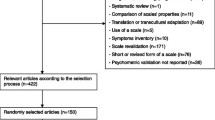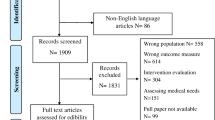Abstract
Purpose
Patient-reported outomes (PRO) may facilitate prompt treatment. We describe the development and psychometric properties of the first instrument to monitor for symptoms of breast cancer (BC) recurrence.
Methods
This study is nested in the MyHealth randomized trial of nurse-led follow-up based on electronically-collected PROs. We constructed items assessing symptoms of potential recurrence through expert interviews with six BC specialists in Denmark. Semi-structured cognitive interviews were carried out with a patient panel to assess acceptability and comprehensibility. Items were subsequently tested in a population of 1170 women 1–10 years after completing BC treatment. We carried out multiple-groups confirmatory factor analysis (CFA) and Rasch analysis to test dimensionality, local dependence (LD) and differential item functioning (DIF) according to sociodemographic and treatment-related factors. Clinical data was obtained from the Danish Breast Cancer Group registry.
Results
Twenty-two items were generated for the Breast Cancer Recurrence instrument (BreastCaRe). Cognitive testing resulted in clearer items. Seven subscales based on general, bone, liver, lung, brain, locoregional and contralateral recurrence symptoms were proposed. Both CFA and Rasch models confirmed the factor structure. No DIF was identified. Five item pairs showed LD but all items were retained to avoid loss of clinical information. Rasch models taking LD into account were used to generate a standardized scoring table for each subscale.
Conclusions
The BreastCaRe has good content and structural validity, patient acceptability and measurement invariance. We are preparing to examine the predictive validity of this new instrument.


Similar content being viewed by others
Data Availability
The data that support the findings of this study are not publicly available due to data protection legislation.
Code availability
Available upon request.
References
Yang, L. Y., Manhas, D. S., Howard, A. F., & Olson, R. A. (2018). Patient-reported outcome use in oncology: a systematic review of the impact on patient-clinician communication. Supportive care in cancer : official journal of the Multinational Association of Supportive Care in Cancer., 26(1), 41–60. https://doi.org/10.1007/s00520-017-3865-7.
Basch, E. M., Deal, A. M., Dueck, A. C., Bennett, A. V., Atkinson, T. M., Scher, H. I., et al. (2017). Overall survival results of a randomized trial assessing patient-reported outcomes for symptom monitoring during routine cancer treatment. Journal of Clinical Oncology, 318(2), 197–198. https://doi.org/10.1200/JCO.2017.35.18_suppl.LBA2.
Chen, J., Ou, L., & Hollis, S. J. (2013). A systematic review of the impact of routine collection of patient reported outcome measures on patients, providers and health organisations in an oncologic setting. BMC Health Services Research, 13, 211. https://doi.org/10.1186/1472-6963-13-211.
Runowicz, C. D., Leach, C. R., Henry, N. L., Henry, K. S., Mackey, H. T., Cowens-Alvarado, R. L., et al. (2016). American Cancer Society/American Society of Clinical Oncology breast cancer survivorship care guideline. CA: A Cancer Journal for Clinicians, 66(1), 43–73. https://doi.org/10.3322/caac.21319.
Howell, D., Molloy, S., Wilkinson, K., Green, E., Orchard, K., Wang, K., et al. (2015). Patient-reported outcomes in routine cancer clinical practice: a scoping review of use, impact on health outcomes, and implementation factors. Annals of Oncology, 26(9), 1846–1858. https://doi.org/10.1093/annonc/mdv181.
Coulter A, Potter C, Peters M, Fitzpatrick R. Cancer PROMs: a scoping study: Macmillan Cancer Support2015.
WHO. Breast cancer burden. 2018. http://www.who.int/cancer/detection/breastcancer/en/index1.html. Accessed 08/08/2018.
Colleoni, M., Sun, Z., Price, K. N., Karlsson, P., Forbes, J. F., Thürlimann, B., et al. (2016). Annual hazard rates of recurrence for breast cancer during 24 years of follow-up: results from the international breast cancer study group trials I to V. Journal of Clinical Oncology, 34(9), 927–935. https://doi.org/10.1200/JCO.2015.62.3504.
Pan, H., Gray, R., Braybrooke, J., Davies, C., Taylor, C., McGale, P., et al. (2017). 20-year risks of breast-cancer recurrence after stopping endocrine therapy at 5 years. New England Journal of Medicine, 377(19), 1836–1846. https://doi.org/10.1056/NEJMoa1701830.
Ahmad, A. (2013). Pathways to breast cancer recurrence. ISRN Oncol, 2013, 16. https://doi.org/10.1155/2013/290568.
Wu, X., Baig, A., Kasymjanova, G., Kafi, K., Holcroft, C., Mekouar, H., et al. (2016). Pattern of local recurrence and distant metastasis in breast cancer by molecular subtype. Cureus., 8(12), e924. https://doi.org/10.7759/cureus.924.
Taggart, F., Donnelly, P., & Dunn, J. (2012). Options for early breast cancer follow-up in primary and secondary care - a systematic review. BMC Cancer, 12(1), 238. https://doi.org/10.1186/1471-2407-12-238.
Pivot, X., Asmar, L., Hortobagyi, G. N., Theriault, R., Pastorini, F., & Buzdar, A. (2000). A retrospective study of first indicators of breast cancer recurrence. Oncology, 58(3), 185–190. https://doi.org/10.1159/000012098.
Saltbæk, L., Horsboel, T. A., Offersen, B. V., Andersson, M., Friberg, A. S., Skriver, S. K., et al. (2020). Patterns in detection of recurrence among patients treated for breast cancer. Breast Cancer Research and Treatment. https://doi.org/10.1007/s10549-020-05847-4.
Denis, F., Lethrosne, C., Pourel, N., Molinier, O., Pointreau, Y., Domont, J., Bourgeois, H., Senellart, H., Trémolières, P., Lizée, T., Bennouna, J., Urban, T., El Khouri, C., Charron, A., Septans, A.-L., Balavoine, M., Landry, S., Solal-Céligny, P., & Letellier, C. (2017). Randomized trial comparing a web-mediated follow up with routine surveillance in lung cancer patients. Journal of the National Cancer Institute. https://doi.org/10.1093/jnci/djx029.
Denis, F., Viger, L., Charron, A., Voog, E., Dupuis, O., Pointreau, Y., et al. (2014). Detection of lung cancer relapse using self-reported symptoms transmitted via an Internet Web-application: pilot study of the sentinel follow-up. Supportive Care in Cancer, 22(6), 1467–1473. https://doi.org/10.1007/s00520-013-2111-1.
Dima, A. L. (2018). Scale validation in applied health research: tutorial for a 6-step R-based psychometrics protocol. Health Psychology and Behavioral Medicine., 6(1), 136–161. https://doi.org/10.1080/21642850.2018.1472602.
Mokkink, L. B., Terwee, C. B., Patrick, D. L., Alonso, J., Stratford, P. W., Knol, D. L., et al. (2010). The COSMIN checklist for assessing the methodological quality of studies on measurement properties of health status measurement instruments: an international Delphi study. Quality of life research : an international journal of quality of life aspects of treatment, care and rehabilitation., 19(4), 539–549. https://doi.org/10.1007/s11136-010-9606-8.
ClinicalTrials.gov. MyHealth: Follow-up After Breast Cancer Treatment (MyHealth). 2016. https://clinicaltrials.gov/ct2/show/NCT02949167.
Saltbæk, L., Karlsen, R. V., Bidstrup, P. E., Høeg, B. L., Zoffmann, V., Horsbøl, T. A., et al. (2019). MyHealth: specialist nurse-led follow-up in breast cancer. A randomized controlled trial – development and feasibility. Acta Oncologica. https://doi.org/10.1080/0284186X.2018.1563717.
Bast, R. C., Croce, C. M., Hait, W. N., Hong, W. K., Kufe, D. W., Piccart-Gebhart, M., et al. (Eds.). (2017). Cancer Medicine. (9th ed.). Wiley-Blackwell: Hoboken, NJ.
Høeg, B. L., Tjørnhøj-Thomsen, T., Skaarup, J. A., Langstrup, H., Zoffmann, V., Saltbaek, L., et al. (2019). Whose perspective is it anyway? Dilemmas of patient involvement in the development of a randomized clinical trial – a qualitative study. Acta Oncologica, 58(5), 1–8. https://doi.org/10.1080/0284186X.2019.1566776.
Aaronson, N. K., Ahmedzai, S., Bergman, B., Bullinger, M., Cull, A., Duez, N. J., et al. (1993). The European Organization for Research and Treatment of Cancer QLQ-C30: a quality-of-life instrument for use in international clinical trials in oncology. Journal of the National Cancer Institute, 85(5), 365–376.
Pedersen, C. B., Gøtzsche, H., Møller, J. Ø., & Mortensen, P. B. (2006). The Danish civil registration system. A cohort of eight million persons. Danish Medical Bulletin, 53, 441–449.
Jensen, M. B., Laenkholm, A. V., Offersen, B. V., Christiansen, P., Kroman, N., Mouridsen, H. T., et al. (2018). The clinical database and implementation of treatment guidelines by the Danish Breast Cancer Cooperative Group in 2007–2016. Acta Oncologica, 57(1), 13–18. https://doi.org/10.1080/0284186x.2017.1404638.
Christensen, K. B., Makransky, G., & Horton, M. (2017). Critical values for Yen’s Q3: Identification of local dependence in the rasch model using residual correlations. Applied Psychological Measurement, 41(3), 178–194. https://doi.org/10.1177/0146621616677520.
Scott NW, Fayers PM, Aaronson PM, Bottomley A, de Graeff A, Groenvold A et al. EORTC QLQ-C30 Reference Values 2008.
Rosseel Y. lavaan: An R Package for Structural Equation Modeling. Journal of Statistical Software; Vol 1, Issue 2 (2012). 2012.
Svetina, D., Rutkowski, L., & Rutkowski, D. (2020). Multiple-group invariance with categorical outcomes using updated guidelines: An illustration using mplus and the lavaan/semtools packages. Structural Equation Modeling: A Multidisciplinary Journal., 27(1), 111–130. https://doi.org/10.1080/10705511.2019.1602776.
Braeken, J., & van Assen, M. (2017). An empirical Kaiser criterion. Psychological Methods, 22(3), 450–466. https://doi.org/10.1037/met0000074.
Schreiber, J. B., Nora, A., Stage, F. K., Barlow, E. A., & King, J. (2006). Reporting structural equation modeling and confirmatory factor analysis results: a review. The Journal of Educational Research., 99(6), 323–338. https://doi.org/10.3200/JOER.99.6.323-338.
Christensen KB, Kreiner S, Mesbah M, editors. Rasch Models in Health. Wiley; 2012.
Kreiner, S., & Christensen, K. B. (2002). Graphical Rasch models. In M. Mesbah, B. F. Cole, & M. L. T. Lee (Eds.), Statistical Methods for Quality of Life Studies: Design, Measurements and Analysis. (pp. 187–203). Boston: Springer.
Smith, R. M., Schumacker, R. E., & Bush, M. J. (1998). Using item mean squares to evaluate fit to the Rasch model. Journal of Outcome Measurement, 2(1), 66–78.
Smith, A. B., Rush, R., Fallowfield, L. J., Velikova, G., & Sharpe, M. (2008). Rasch fit statistics and sample size considerations for polytomous data. BMC Medical Research Methodology, 8, 33. https://doi.org/10.1186/1471-2288-8-33.
Christensen K, Kreiner S. Item Fit Statistics. In: Christensen K, Kreiner S, Mesbah M, editors. Rasch Models in Health. 2013. p. 83–104.
Kreiner, S., & Christensen, K. B. (2013). Two Tests of Local Independence. In K. B. Christensen, S. Kreiner, & M. Mesbah (Eds.), Rasch Models in Health Hoboken. (pp. 131–136). NJ: John Wiley & Sons.
Kreiner, S., & Christensen, K. B. (2011). Item screening in graphical loglinear rasch models. Psychometrika, 76(2), 228–256. https://doi.org/10.1007/s11336-011-9203-y.
Kreiner S, Christensen KB. Overall Tests of the Rasch Model. In: Kreiner S, Christensen KB, Mesbah M, editors. Rasch Models in Health. 2013. p. 105–10.
Warm, T. A. (1989). Weighted likelihood estimation of ability in item response theory. Psychometrika, 54(3), 427–450. https://doi.org/10.1007/BF02294627.
Christensen, K. B. (2013). Conditional maximum likelihood estimation in polytomous rasch models using SAS. ISRN Computational Mathematics, 2013, 1–8.
Christensen, K. B. (2006). Fitting polytomous Rasch models in SAS. Journal of Applied Measurement, 7(4), 407–417.
Kreiner S, Nielsen T. Item analysis in DIGRAM 3.04: Part I: Guided tours. Department of Biostastistics, University of Copenhagen 2013.
Martinková, P., Drabinová, A., Liaw, Y.-L., Sanders, E. A., McFarland, J. L., & Price, R. M. (2017). Checking equity: why differential item functioning analysis should be a routine part of developing conceptual assessments. CBE Life Sciences Education. https://doi.org/10.1187/cbe.16-10-0307.
Bradley, C., & Massof, R. W. (2018). Method of successive dichotomizations: An improved method for estimating measures of latent variables from rating scale data. PLoS ONE. https://doi.org/10.1371/journal.pone.0206106.
Samejima, F. (1969). Estimation of latent ability using a response pattern of graded scores. Psychometrika, 34(1), 1–97. https://doi.org/10.1007/BF03372160.
Müller, M. (2020). Item fit statistics for Rasch analysis: can we trust them? Journal of Statistical Distributions and Applications., 7(1), 5. https://doi.org/10.1186/s40488-020-00108-7.
Montgomery, D. A., Krupa, K., & Cooke, T. G. (2007). Alternative methods of follow up in breast cancer: a systematic review of the literature. British Journal of Cancer, 96(11), 1625–1632. https://doi.org/10.1038/sj.bjc.6603771.
DeSantis, C., Ma, J., Bryan, L., & Jemal, A. (2014). Breast cancer statistics, 2013. CA: A Cancer Journal for Clinicians, 64(1), 52.
Acknowledgements
We wish to thank our expert panel (senior consultants Dr Birgitte Offersen, Dr Michael Andersson, Dr Niels Kroman, and Dr Anders Bonde), our patient panel, and Julie A. Skaarup, who carried out the patient cognitive interviews. We also thank Visti B. Larsen for his invaluable assistance in data management.
Funding
The MyHealth trial was funded by the Danish Cancer Society, Region Zealand, Rigshospitalet (Copenhagen University Hospital) and the Capital Region of Denmark.
Author information
Authors and Affiliations
Contributions
All authors contributed to the study conception and design, data collection, analysis and/or interpretation. All authors contributed to and approved the final manuscript.
Corresponding author
Ethics declarations
Conflict of interest
All authors declare no conflict of interest.
Additional information
Publisher's Note
Springer Nature remains neutral with regard to jurisdictional claims in published maps and institutional affiliations.
Supplementary Information
Below is the link to the electronic supplementary material.
Rights and permissions
About this article
Cite this article
Høeg, B.L., Saltbæk, L., Christensen, K.B. et al. The development and initial validation of the Breast Cancer Recurrence instrument (BreastCaRe)—a patient-reported outcome measure for detecting symptoms of recurrence after breast cancer. Qual Life Res 30, 2671–2682 (2021). https://doi.org/10.1007/s11136-021-02841-1
Accepted:
Published:
Issue Date:
DOI: https://doi.org/10.1007/s11136-021-02841-1




